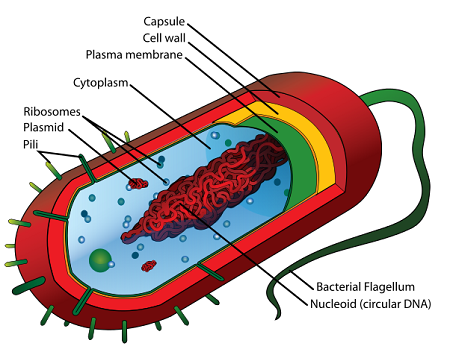4.2 – THE GENETICS OF BACTERIA
| 10 Students |
| Grade 11-12 |
COURSE DESCRIPTION
The structure of DNA was proposed by Watson and Crick in 1953. With an understanding of DNA structure, experimental evidence supported the proposal that DNA replicates in a semi-conservative manner. The central dogma states that genetic information is encoded in the DNA and transferred to the mRNA during translation. In addition to mRNA transcription, tRNA and rRNA are transcribed; tRNA is needed during translation while rRNA is a component of ribosomes. In eukaryotic transcription, pre-mRNA is synthesised and then processed to produce mature mRNA. Subsequently, through translation, the information on the mRNA is used to synthesise polypeptides, which are folded into functional proteins.
The nuclear genomes of eukaryotes differ greatly in size, number of genes and gene density from one another. The number of chromosomes differs between species and, in addition, certain organelles in eukaryotes possess small amounts of their own DNA. Eukaryotic genomes generally have a higher proportion of non-coding DNA to coding DNA. In addition to a large, circular chromosome, bacteria also have several plasmids. Even though bacteria reproduce asexually, they exhibit a great deal of genetic diversity through mutation and genetic transfer. In contrast to eukaryotic and prokaryotic genomes, the viral genome varies according to the types of virus: the genome may be DNA or RNA in nature and single-or double-stranded. For RNA viruses, they may possess either positive-sense RNA (i.e. identical to viral mRNA and thus can be immediately translated) or negative-sense RNA (i.e. complementary to viral mRNA and thus must be converted to positive-sense RNA by RNA polymerase before translation).
In prokaryotes, operons, like the trp and lac operons, regulate gene expression using repressible and inducible systems. Regulatory genes encode proteins that control transcription of structural genes. In eukaryotes, regulation of gene expression can occur at the chromatin level, transcriptional level, post-transcriptional level, translational level and/or even post-translation level. Basic molecular techniques allow scientists to study gene expression.
Learning Outcomes
Candidates should be able to:
1(a) Outline the cell theory with the understanding that cells are the smallest unit of life, all cells come from pre-existing cells, and living organisms are composed of cells
1(d) Describe the structure of a typical bacterial cell (small and unicellular, peptidoglycan well wall, circular DNA, 70S ribosomes and lack of membrane-bound organelles)
2(c) Describe how the information on DNA is used to synthesise polypeptides in prokaryotes and eukaryotes (description of the processes of transcription, formation of mRNA from pre-mRNA and translation is required)
2(d) Describe the structure and organisation of viral, prokaryotic and eukaryotic genomes (including DNA/RNA, single-/double-stranded, number of nucleotides, packing of DNA, linearity / circularity and presence/absence of introns)
2(g) Outline the mechanism of asexual reproduction by binary fission in a typical prokaryote and describe how transformation, transduction and conjugation (including the role of F plasmids but not Hfr) give rise to variation in prokaryotic genomes
2(i) Explain how gene expression in prokaryotes can be regulated, through the concept of simple operons (including lac and trp operons), including the role of regulatory genes, and distinguish between inducible and repressible systems (knowledge of attenuation of the trp operon is not required)
Use the knowledge gained in this section in new situations or to solve related problems.
LECTURE OUTLINE
- Bacterial Morphology and Cell Ultrastructure
1.1 Morphology
1.2 Cell Ultrastructure
1.2.1 Cell Surface Structures
1.2.2 Cytoplasmic Structures
1.2.3 Comparison of Prokaryotic and Eukaryotic Cell Ultrastructure
1.2.4 Endosymbiont Theory
- Prokaryotic Genome
2.1 Bacterial Chromosome
2.2 Plasmids
- Role of Genetic Material in Bacteria
3.1 Transmission of Genetic Material from Parent to Offspring – Binary Fission
3.2 Transfer of Genetic Material from One Cell to Another
3.2.1 Transformation
3.2.2 Transduction
3.2.2.1 Generalized Transduction
3.2.2.2 Specialized Transduction
3.2.2.3 Comparison of Generalized and Specialized Transduction
3.2.3 Conjugation
Concept Check 1
3.3 Prokaryotic Gene Expression
3.3.1 Structure & Organisation of Prokaryotic Genes
3.3.1.1 Grouping of Functionally Related Structural Genes – Operon
3.3.2 Prokaryotic Transcription
3.3.2.1 Stage 1: Initiation
3.3.2.2 Stage 2: Elongation
3.3.2.3 Stage 3: Termination
3.3.3 Prokaryotic Translation
3.3.3.1 Stage 1: Initiation
3.3.3.2 Stage 2: Elongation
3.3.3.3 Stage 3: Termination
3.4 Control of Prokaryotic Gene Expression
3.4.1 Coordinated Control of Gene Expression – Operon
3.4.1.1 Structure of an Operon
3.4.1.2 Regulation of an Operon
3.4.2 Example of a Repressible Operon – trp Operon
3.4.3 Example of an Inducible Operon – lac Operon
3.4.3.1 Negative Regulation of lac Operon – lac Repressor
3.4.3.2 Positive Regulation of lac Operon – Catabolite Activator Protein
3.4.4 Comparison of Inducible and Repressible Operons
Concept Check 2
Requirements
- Donec porta ultricies urna, faucibus magna dapibus.
- Etiam varius tortor ut ligula facilisis varius in a leo.
- Folutpat tempor tur duis mattis dapibus, felis amet.
- Donec porta ultricies urna, faucibus magna dapibus.
- Etiam varius tortor ut ligula facilisis varius in a leo.
- Folutpat tempor tur duis mattis dapibus, felis amet.
What is the target audience?
- This course is intended for anyone interested in learning to master his or her own body.
- This course is aimed at beginners, so no previous experience with hand balancing skillts is necessary
Aenean viverra tincidunt nibh, in imperdiet nunc. Suspendisse eu ante pretium, consectetur leo at, congue quam. Nullam hendrerit porta ante vitae tristique. Vestibulum ante ipsum primis in faucibus orci luctus et ultrices posuere cubilia Curae; Vestibulum ligula libero, feugiat faucibus mattis eget, pulvinar et ligula.
CURRICULUM
Section 1: Introduction to Handstands
Section 2: Reference Material, Moodboards and Mind Mapping
Wrist Strengthening
While your wrists will certain get stronger from practice and grow accustomed to the stress of the skill, a basic amount of wrist strengthening exercises for several weeks can only help things. I’d recommend working wrist curls and reverse wrist curls for around 6-10 reps for 3 sets. I also strongly recommend trying some sledgehammer levering. Work in 2-3 sets of 3-5 reps. In particular, exercises 1 and 3 are fantastic for building wrist strength and they are much harder than they look! Start with them to get the hang of sledgehammer work before you progress to the other two exercises. I don’t want somebody putting a hole through their floor or their face because they rushed things!Section 3: Sketching out Ideas
- The main objective to the sketching process is to generate super rough thumbnail sketches of what we feel best visually communicates the highlighted words from our mind maps.
- Take as much time as you need for this step — this might be 10 minutes or it might be 10 days.
- Personally, I like to work quickly and try not to analyze or elaborate too much.
- Now, that doesn't mean you should only create a handful of sketches.
- Even though this step only took a couple of hours, I was still able to put over 100 thumbnails on paper.
- The whole point of this process is to flush out the bad ideas and narrow down the good ones until we find that one layout that really speaks to us.
- Also, keep in mind the project brief and have your list in front of you as a reference to avoid getting sidetracked.
- Remember—detail is not needed. Simply flush out the bad ideas and find a great direction.
- Once I feel I have a good direction with the sketches, I'm now ready to take a quick photo with my phone and import it into Illustrator.
Section 4: Conclusions and Evaluation
About Instructors
Reviews
Average Rating
Detailed Rating
| Stars 5 |
|
0 |
| Stars 4 |
|
0 |
| Stars 3 |
|
0 |
| Stars 2 |
|
0 |
| Stars 1 |
|
0 |
Be the first to review “4.2 – THE GENETICS OF BACTERIA” Cancel reply
| 10 Students |
| Grade 11-12 |



There are no reviews yet.